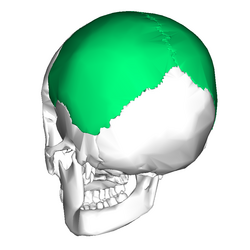Loading AI tools
Bone in the human skull which, when joined together, forms the sides and roof of the cranium From Wikipedia, the free encyclopedia
The parietal bones (/pəˈraɪ.ɪtəl/ pə-RY-it-əl) are two bones in the skull which, when joined at a fibrous joint known as a cranial suture, form the sides and roof of the neurocranium. In humans, each bone is roughly quadrilateral in form, and has two surfaces, four borders, and four angles. It is named from the Latin paries (-ietis), wall.
| Parietal bone | |
|---|---|
 Position of the parietal bones | |
| Details | |
| Articulations | Five bones: the opposite parietal, the occipital, frontal, temporal, and sphenoid |
| Identifiers | |
| Latin | os parietale |
| MeSH | D010294 |
| TA98 | A02.1.02.001 |
| TA2 | 504 |
| FMA | 9613 |
| Anatomical terms of bone | |
The external surface [Fig. 1] is convex, smooth, and marked near the center by an eminence, the parietal eminence (tuber parietale), which indicates the point where ossification commenced.
Crossing the middle of the bone in an arched direction are two curved lines, the superior and inferior temporal lines; the former gives attachment to the temporal fascia, and the latter indicates the upper limit of the muscular origin of the temporal muscle.
Above these lines the bone is covered by a tough layer of fibrous tissue – the epicranial aponeurosis; below them it forms part of the temporal fossa, and affords attachment to the temporal muscle.
At the back part and close to the upper or sagittal border is the parietal foramen which transmits a vein to the superior sagittal sinus, and sometimes a small branch of the occipital artery; it is not constantly present, and its size varies considerably.
The internal surface [Fig. 2] is concave; it presents depressions corresponding to the cerebral convolutions, and numerous furrows (grooves) for the ramifications of the middle meningeal artery; the latter run upward and backward from the sphenoidal angle, and from the central and posterior part of the squamous border.
Along the upper margin is a shallow groove, which, together with that on the opposite parietal, forms a channel, the sagittal sulcus, for the superior sagittal sinus; the edges of the sulcus afford attachment to the falx cerebri.
Near the groove are several depressions, best marked in the skulls of old persons, for the arachnoid granulations (Pacchionian bodies).
In the groove is the internal opening of the parietal foramen when that aperture exists.
The parietal bone is ossified in membrane from a single center, which appears at the parietal eminence about the eighth week of fetal life.
Ossification gradually extends in a radial manner from the center toward the margins of the bone; the angles are consequently the parts last formed, and it is here that the fontanelles exist.
Occasionally the parietal bone is divided into two parts, upper and lower, by an antero-posterior suture.

In non-human vertebrates, the parietal bones typically form the rear or central part of the skull roof, lying behind the frontal bones. In many non-mammalian tetrapods, they are bordered to the rear by a pair of postparietal bones that may be solely in the roof of the skull, or slope downwards to contribute to the back of the skull, depending on the species. In the living tuatara and some lizards, as well as in many fossil tetrapods, a small opening, the parietal foramen (also called the pineal foramen), is present between the two parietal bones at the midline of the skull. This opening is the location of the parietal eye (also called the pineal or third eye), which is much smaller than the two main eyes.[1][2][3]
The parietal bone is usually present in the posterior end of the skull and is near the midline. This bone is part of the skull roof, which is a set of bones that cover the brain, eyes and nostrils. The parietal bones make contact with several other bones in the skull. The anterior part of the bone articulates with the frontal bone and the postorbital bone. The posterior part of the bone articulates with the squamosal bone, and less commonly the supraoccipital bone. The bone-supported neck frills of ceratopsians were formed by extensions of the parietal bone. These frills, which overhang the neck and extend past the rest of the skull is a diagnostic trait of ceratopsians. The recognizable skull domes present in pachycephalosaurs were formed by the fusion of the frontal and parietal bones and the addition of thick deposits of bone to that unit.[4]
Seamless Wikipedia browsing. On steroids.
Every time you click a link to Wikipedia, Wiktionary or Wikiquote in your browser's search results, it will show the modern Wikiwand interface.
Wikiwand extension is a five stars, simple, with minimum permission required to keep your browsing private, safe and transparent.